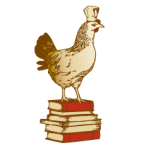Kathleen Flinn's Blog, page 24
January 22, 2013
The Tricky Business of Tasting the Past
Behold what I call “The Shroud of Turin Chicken Pot Pie,” a scan of a page unearthed from the bottom of my grandmother Inez Monk Henderson’s recipe file. Folded carefully, it marked an obvious attempt to capture in the barest forms a recipe she didn’t want to forget, or perhaps, had planned to give to someone else to decipher. She had made notes on the folded exteriors for recipes as well, one too faded to detect, the other for dill pickles.
I’ve been going through my family’s recipes as part of research for my third book. It’s best described as a multi-generational memoir with recipes. I don’t even show up until Chapter 6. (I’ve not quite figured out how to tackle that part, actually.) My mother’s recipes are a bit neater, captured in two spiral notebooks. Originally, grandma stuffed hers in an old accordion envelope, but in the late 1950s, someone gave her a green box and she transferred them all there. Grandma didn’t collect many recipes for daily cooking. It’s notable that nowhere in her files does she have any recipes for soup or roasts, for instance. Why would she? You made soup with leftovers and she knew all her standards by heart. Older, more yellowed pieces of newspaper involved cakes made with mayonnaise or cookies starring cheap ingredients. Later recipes leaned toward more ”elegant” or “modern” recipes for her time, such as Chicken Divan.
Mom and I think this page comes from the late 1940s. Notice the short-hand: “Two onion – cut up.” “One chicken – 3 1/2 pounds, boiled until tender.”Also, I point your attention to the absence of salt, pepper or other seasonings but the inclusion of “1 can mushrooms soup.” All of it in “chicken scratch,” how she referred to her own handwriting. She left formal education at age 13 in the early 1920s, when her father was killed in a lumber mill accident. She was forced to stay at home and help rear four brothers and sisters. She married my grandfather, Charles, when she was 16 presumably because taking care of one husband was easier than a bunch of kids. Of course, she then proceeded to have five kids herself, most of them born in the grips of The Great Depression.
As I’ve wandered down this flour-and-bacon-grease-splattered memory lane, I’m struck by how the language of recipes changed even in the short years spanned in my grandmother’s recipe box. Some of the recipes she wrote or collected from friends were little more than ingredient lists with a couple of notes. Everyone understood the language of the kitchen. One of her recipes starts, “Kill and clean two good-sized chickens.”
She died in 1979, ahead of a world filled with arugula, sun-dried tomatoes and truffle oil. Yet, she also fell somehow ahead of the curve. She lived seasonally and organically for most of her life not because it was trendy or she worried about climate change or felt dissatisfied or disillusioned with her options at the supermarket. She grew up poor, so it wasn’t a choice. Up to the day she died at the untimely age of 69, she grew the vast majority of her vegetables. She and grandpa canned every autumn. They didn’t believe in store-bought jelly. When grandpa was alive, he grew his own pigs and made his own ham and bacon. They raised chickens and taught my mom at age 11 how to kill and clean them.
As I work through trying to recreate these dishes, as much as I long for a taste of the past, I have to admit how much I’ve been influenced by the present. That stewed chicken I loved so much as a kid? It tastes so bland to me now. More than once I’ve wondered, does every dish really need paprika? I’ve found myself adding garlic and cayenne, a hit of lemon or sprigs of fresh herbs to bring the flavor in line with the palate that I have now.
Which leads me to a dilemma. Do I present the recipes as I think they were made originally without any changes? Or do I adapt to modern palates? I think my grandmother would have loved garlic – she just never used it growing up, so it stayed in her blind spot. Sure, she made cakes with mayonnaise. But is that helpful or interesting, or just a culinary anachronism? Just what I am to do with those Campbell’s Soup-based casseroles?
When I wonder all of this, I think back to this recipe and to the spirit of my grandma, an outspoken pragmatist who herself was never a slave to a recipe. After all, for 26 years Inez lived in a remote town where the nearest store was a dozen miles away – and she never learned to drive. She could only cook with what she had on hand. Plus, she felt it a sin to let food go to waste. How else to explain minced rhubarb in a chocolate cake? Or sweet potatoes in chicken stew? Or that despite calling for butter, she made virtually everything with the bacon grease she kept in a coffee can on the back of her stove?
If I presented this dilemma to her, I know exactly what she’d say. “Really, Kathleen Inez, have you nothing better to do? Then go sweep the porch.” She’d shove a broom in my hand and send me out as she finished dinner the way she always cooked: A bit of this, a bit of that and a fistful of green beans leftover from last night and why not just throw in that extra gravy? Grandma was not a chef, but she a real cook. She was driven by love and economy, and in neither could she afford to be a purist.


December 14, 2012
How Do Processed Holiday Classics Compare to Homemade?
For years, a relative of mine served boxed stuffing at her holiday gatherings, spiced up with cut-up pre-cooked turkey sausage. When I offered to make some homemade stuffing one year, she waved me off. “No one can the tell the difference, anyway.”
Funny, but I could absolutely tell the difference. Was it just me? I contemplated on how real mashed potatoes, gravy, fresh green beans and cranberry sauce would stack up to their processed cousins. What about supermarket turkey versus a fresh, organic bird?
To find out, I made two dinners, one with fresh side dishes and a fancy turkey, the other with packaged sides and a supermarket bird. To test them, I gathered a panel of objective judges — the firefighters from my local firehouse. The result? Find out in our in-depth look – plus get my favorite recipes — in the Firehouse Challenge on my new site, CookFearless.com


November 15, 2012
Amazon lists best food books of 2012
This week, Amazon announced the Best Books of 2012, including two separate categories for voracious food readers.
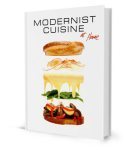
 At the top of the Cookbook category, we have Ina Garten’s Barefoot Contessa Foolproof: Recipes You Can Trust, Deb Perelman’s Smitten Kitchen and Nathan Myhrvold and Maxime Bilet’s Modernist Cuisine at Home.
At the top of the Cookbook category, we have Ina Garten’s Barefoot Contessa Foolproof: Recipes You Can Trust, Deb Perelman’s Smitten Kitchen and Nathan Myhrvold and Maxime Bilet’s Modernist Cuisine at Home.
Then, over in Food Lit, titles include Bee Wilson’s Consider the Fork and Bob Spitz’s Julia Child bio hit Dearie. Luisa Weiss’ My Berlin Kitchen also made the cut.
Amazon is offering all the “Best Books” at 40 percent off now through the end of the year.
What do you think should have made the list?


October 22, 2012
Book tour takes me to Tampa
…. now say that five times fast.
The paperback tour for The Kitchen Counter Cooking School, which, by the way, has been equally exciting and exhausting, is coming to a close BUT not before a visit to Tampa and Inkwood Books. 
On Thursday, Oct. 25, I’ll be at Inkwood celebrating with wine, small bites from the book and cooking demos starting at 7 p.m. As always, I’m happy to sign copies.
I have the kind folks at Inkwood to thank for my Indie Next List honor, so obviously their store and this event are important to me, and of course I’d love for you join us for good food and great company.
Also, if you’d like to see what I’ve been up to along the way, check out the recent press links under the “Books” tab on my site. Here’s a taste: Become a Fearless Home Cook


October 9, 2012
Wine, dine and demos in San Diego
The paperback tour for The Kitchen Counter Cooking School takes me to San Diego in a little more than a week for two interactive events, and I’d love for you to join m
On Oct. 16, I’ll give the keynote speech (followed by Q & A) at a fundraiser dinner ($75-$95) for the American Institute of Wine and Food (AIWF). We’ll be housed in San Diego’s popular Table 926 restaurant. 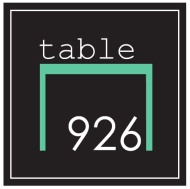 Dinner starts at 6 p.m., and you can make reservations by calling AIWF at (619) 297-0951. Books will be available for purchase, and I’ll be more than happy to sign one for you.
Dinner starts at 6 p.m., and you can make reservations by calling AIWF at (619) 297-0951. Books will be available for purchase, and I’ll be more than happy to sign one for you.
If you can’t make it to the AIWF dinner, the Junior League of San Diego is hosting me  next evening at 6 p.m. I’ll do interactive cooking demos and discuss the book, all while you enjoy wine and light appetizers. Attendance is $10 ($27 if book is included). Again, if you buy a book, I’ll gladly sign it.
next evening at 6 p.m. I’ll do interactive cooking demos and discuss the book, all while you enjoy wine and light appetizers. Attendance is $10 ($27 if book is included). Again, if you buy a book, I’ll gladly sign it.


October 4, 2012
Food Writing Boot Camp in Washington D.C. on October 9th
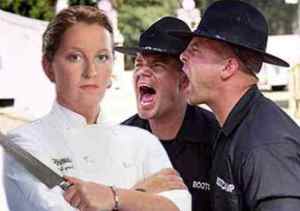 Anyone who has taken my food writing classes knows that I have great passion for teaching. So I’m excited that my D.C. stop for The The Kitchen Counter Cooking School paperback tour includes one stop featuring a writing class .
Anyone who has taken my food writing classes knows that I have great passion for teaching. So I’m excited that my D.C. stop for The The Kitchen Counter Cooking School paperback tour includes one stop featuring a writing class .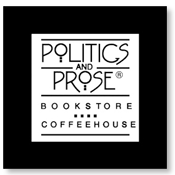
On Oct. 9, I’ll be at D.C.’s famous Politics & Prose bookstore from 1 p.m. to 3 p.m. teaching a “Food Writing Boot camp” focused on some key fundamentals of food writing. We’ll touch on several areas, from narrative food writing, to recipes to writing exercises to help learn the keys to writing delicious detail. Students will leave armed with a portion of the thick work book that I use for my weekend-long Hungry for Words boot camps at Richard Hugo House in Seattle that includes more writing exercises, loads of writing examples from a dozen writers and a lengthy reading list. It’s $40 ($35 for Politics & Prose members) for the two-hour class. Since its food writing, we’ll also have small bites to nibble on. Unlike the photo, there will be no yelling. In fact, I’m kind of a low talker, so you may need to lean in to hear me. More info at Politics & Prose.
If you’re in D.C., you can also catch me on Let’s Talk Live (NewsChannel 8) around 11 a.m. that Tuesday morning. I’ll be doing an interview and a demo. Tune in to find out what I’ll be cooking up.
By the way, I’m planning a series of food writing classes in 2013 in various parts of the country and – drum roll – Paris! To get updates, just drop me a line.


How about cocktails or lunch in San Francisco?
Looking for a place to mingle with food-minded folks in the San Francisco area? Well, have I got two fun, food-centered events for you.
I’ll be in San Fran Oct. 12-13 to promote the paperback launch of my second book, The Kitchen Cooking School.
My first stop is a cocktail party at the city’s fabulous food-focused bookstore, Omnivore Books on Food at 6 p.m. Friday, Oct. 12. Totally free, totally fun. Come mingle and pick up a signed copy of my book.
The next event is a lovely luncheon at Rakestraw Books in Danville, Calif. on Saturday, Oct. 13. I’ll discuss the book and sign copies. Lunch starts at noon. It’s $10 per person. Don’t forget to RSVP through Rakestraw’s site.
Looking forward to seeing and/or meeting you!


September 28, 2012
Friday Reads: Roots & Meat
Two exceptional food authors are coming to town for the Chef’s Collaborative National Sustainable Food Summit, each armed with an extraordinary new (and hefty) book from the far ends of the food spectrum. I am deeply engrossed in both this week.
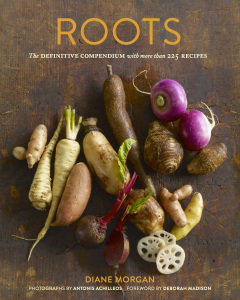 Diane Morgan, a prolific food writer with more than 17 books to her name, comes to town to promote Roots: The Definitive Compendium with more than 225 Recipes (Chronicle Books). Rutabagas, parsnips and carrots never looked so sexy, thanks to the photography of Antonis Achilleos. Diane’s research is exhaustive, the prose compelling and the whole book endlessly educational. Sure, we all know about potatoes, sweet potatoes and beets, but honestly, I didn’t know water chestnuts were a root, nor have I ever gave much thought to the possibilities of yuca or taro. (She includes a chapter on salsify, which readers of The Sharper Your Knife may remember as one of the required items in my final exam from Le Cordon Bleu; I’d never heard of it until that test.) The bulk of the 225 recipes are vegetarian friendly, an approach that I assume allows the roots to be the star, rather than the supporting player, as they tend to be relegated in their normal lives.
Diane Morgan, a prolific food writer with more than 17 books to her name, comes to town to promote Roots: The Definitive Compendium with more than 225 Recipes (Chronicle Books). Rutabagas, parsnips and carrots never looked so sexy, thanks to the photography of Antonis Achilleos. Diane’s research is exhaustive, the prose compelling and the whole book endlessly educational. Sure, we all know about potatoes, sweet potatoes and beets, but honestly, I didn’t know water chestnuts were a root, nor have I ever gave much thought to the possibilities of yuca or taro. (She includes a chapter on salsify, which readers of The Sharper Your Knife may remember as one of the required items in my final exam from Le Cordon Bleu; I’d never heard of it until that test.) The bulk of the 225 recipes are vegetarian friendly, an approach that I assume allows the roots to be the star, rather than the supporting player, as they tend to be relegated in their normal lives. 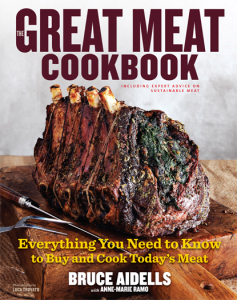 The other massive book on my kitchen counter is The Great Meat Cookbook by Bruce Aidells, published by Houghton Mifflin Harcourt. You might recognize Bruce from the packages of his sausages sold across the country. He’s a guy who knows his meat (no lewd context intended), and it shows in the pages of this exceptional book. When I’ve interviewed home cooks, one thing they frequently comment is that meat can be a mystery. So many cuts, so much lingo and, honestly, so much money. Many home cooks tend to stay within their comfort zone, unclear of whether they can grill certain cuts, or if they need braising. Fear not, Bruce explains all of this for you and then goes on to share more on the subject with strong visuals including loads of excellent charts, at-a-glance guides and charts than you may ever need, but it’s there if you do. He also addresses subjects relevant to modern issues for omnivores, tackling issues around sustainable farming, buying local, humanely raised cattle and so on.
The other massive book on my kitchen counter is The Great Meat Cookbook by Bruce Aidells, published by Houghton Mifflin Harcourt. You might recognize Bruce from the packages of his sausages sold across the country. He’s a guy who knows his meat (no lewd context intended), and it shows in the pages of this exceptional book. When I’ve interviewed home cooks, one thing they frequently comment is that meat can be a mystery. So many cuts, so much lingo and, honestly, so much money. Many home cooks tend to stay within their comfort zone, unclear of whether they can grill certain cuts, or if they need braising. Fear not, Bruce explains all of this for you and then goes on to share more on the subject with strong visuals including loads of excellent charts, at-a-glance guides and charts than you may ever need, but it’s there if you do. He also addresses subjects relevant to modern issues for omnivores, tackling issues around sustainable farming, buying local, humanely raised cattle and so on.
Both will be signing books with me at the author’s event for the Chef’s Collaborative Summit, but alas, you need a ticket to gain entry. For those who’d like to meet these two amazing authors, they’re both doing events in Seattle next week. Bruce will be leading an ultra cool butchery lesson at Rain Shadow Meats on Capitol Hill on Tuesday, Oct. 2nd. If you have any interest in meat or butchery, go to this event. It’s a rare chance for a small-scale event with someone so knowledgeable and to be able to ask questions up close and personal, plus there’s a hearty buffet of all the class results included. The event is $80 and includes a copy of the book.
Both are doing events at The Book Larder in Seattle. Diane will be doing her event on Tuesday, October 2nd and Bruce will be at the store on Wednesday, Oct. 3rd. Both events start at 6:30 and include a nominal entrance fee that includes food bites and beverages. Not in Seattle? Both are doing a national tour for their titles. Diane has her events listed here. You can keep up with Bruce’s tour plans on his Facebook page.
For dinner, I’m combining both books. I’m braising flank steaks, but making a side butter-roasted rutabagas. I wouldn’t want to be accused of playing favorites.


September 25, 2012
Paperback goes on sale today!
 It’s official: the paperback of The Kitchen Counter Cooking School went on sale today. I’m pretty psyched about it being made available in paperback as this opens up the message of the book to a wider audience, plus more book clubs are likely to read it. I’ve had amazing feedback from the clubs that took the plunge and tackled it in hardcover. Rather than sit around and simply discuss plot or which characters they liked or didn’t like, I had reports of people exploring the host’s fridge or assembling various everyday kitchen items to sample. I was so inspired that I wrote a special Book Club Guide with all kinds of activities, in addition to the usual discussion questions and Q&A with the author. (If you didn’t know this already, the reason why so many authors sound remarkably articulate in the back-of-the-book Q&As is simple: they write it themselves. Seriously, look at the Book Club Guide. That’s me interviewing myself. Don’t I sound intelligent?)
It’s official: the paperback of The Kitchen Counter Cooking School went on sale today. I’m pretty psyched about it being made available in paperback as this opens up the message of the book to a wider audience, plus more book clubs are likely to read it. I’ve had amazing feedback from the clubs that took the plunge and tackled it in hardcover. Rather than sit around and simply discuss plot or which characters they liked or didn’t like, I had reports of people exploring the host’s fridge or assembling various everyday kitchen items to sample. I was so inspired that I wrote a special Book Club Guide with all kinds of activities, in addition to the usual discussion questions and Q&A with the author. (If you didn’t know this already, the reason why so many authors sound remarkably articulate in the back-of-the-book Q&As is simple: they write it themselves. Seriously, look at the Book Club Guide. That’s me interviewing myself. Don’t I sound intelligent?)
Since I’m on deadline for my third book already, I’m doing a more limited book tour for the paperback than usual. I may be adding some events in New York in November, too. Authors complain about the grueling nature of book tour, but I like going out and meeting booksellers, readers, the curious and even the folks who stroll into an event hoping for free food. (I always have food and/or drink at my events, should this sway you one way or another.)
Paperback tour dates for The Kitchen Counter Cooking School:
The Book Larder, Seattle, 9/25 (*$20 party admission includes copy of book)
Third Place Books, Lake Forest Park, 9/26
Taste of Atlanta, Atlanta, 10/7 (Book signing in Barnes & Noble tent)
Politics & Prose, Washington D.C., 10/9 (Food Writing Boot Camp, $35)
Books & Books, Gables, Fla., 10/10
Omnivore Books on Food, San Francisco, 10/12 (Friday night cocktail party)
Rakestraw Books, Danville, Calif., 10/13 (Luncheon and book signing)
American Institute of Wine & Food, Pacific Beach, Calif., 10/16 (Keynote speaker for fundraiser dinner)
Junior League, San Diego, 10/17 (More details TBD)
Inkwood Books, Tampa, Fla., 10/25 (More details TBD)
For more details, visit the Events page. I hope to see you in person. If not, I’ll be doing a live chat in October. Stay tuned.


September 21, 2012
Friday Reads: Why food still matters
If I told you Mark Bittman visited Seattle Wednesday to complain to a packed auditorium about the prevalence of UFOs in America, you’d probably think the food writer had gone batty. But Bittman wasn’t bemoaning spaceships or alien invaders. He was talking about unidentifiable food objects (that’s UFOs) such as Cheetos, Doritos and other non-foods, and the fact that the food industry peddles more of them than you can shake an organic carrot at.
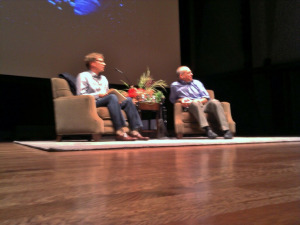
Mark Bittman answers audience questions, including “What’s your favorite vegetable?” A word to the wise: Bittman doesn’t pick favorites, at least when it comes to veggies, and he’d appreciate if you’d stop asking him.
It was great to see someone articulate what needs to be said about food in this country and fascinating to watch Bittman lay out America’s multi-faceted food issues, which involve not just big food corporations, but our government, our farmers and our environment, all of us.
His stats were sobering, though many of us probably could have guessed them. We heard about the trillions of advertising dollars that go into enticing kids to eat junk food and the reality that, in the food biz, you can get a hamburger for $1 when a salad is $4. I was reminded of how even healthful real foods like pomegranates aren’t embraced by the industry unless they’re marketed in some sexy packaging like POM Wonderful.
Despite the facts, it’s not as bleak as we might think. If you want to ensure you’re eating good food, real food, the best thing you can do is cook it yourself. People know Bittman from his simple recipes in How to Cook Everything, but after his talk, I went back to read his ebook, Cooking Solves Everything. If you know anything about my second book, you’ll understand why I agree with the arguments he makes in that title. Studies show that, in general, people who cook weigh less and have fewer health problems. Part of that is because when you cook, rather than say go through a drive-thru, you’re more likely to eat real food with less sodium, less sugar and more fiber. We also tend to eat less of the truly unhealthy stuff such as deep-fried foods. It’s easy to order french fries in a restaurant — it’s not so simple to make them at home.
Sometimes maybe you’ll have one of those $1 hamburgers or even a UFO here and there. At the end of the day, what’s important is making the best choices as often as possible.




